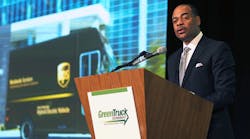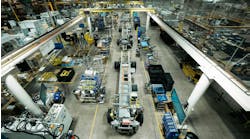UPS’s Rose says electric fleets could change the world. But he won’t predict it.
INDIANAPOLIS. Fleets adopting vehicle electrification could change the world, according to Carlton Rose, the UPS president of global fleet maintenance. But it’s going to take OEMs and utility companies working with fleets to make electrification irresistible in the future.
It’s a future that’s not here yet but it could be, Rose told a group of fleet managers, truck manufacturers and more during the Green Truck Summit on Tuesday, March 5, which kicked off the 2019 Work Truck Show at the Indiana Convention Center. But Rose said he wasn’t here to predict the future.
“I have one big problem with predictions: they are wrong more than they are right,” he said. “In 1957, Popular Mechanics predicted that in 10 years, by 1967, you’d be able to order a light truck that would fly using fans. Didn’t happen. In 2013, futurists said self-driving vehicles would be standard by 2018. Nope. Didn’t happen.”
The reason these and other predictions about the future are often wrong, Rose said, “is because predictions rest on the assumptions that the future is like the past. And we know better than that.”
So when Rose looks at what technology UPS (which ranks No. 1 on the Fleet Owner For-Hire 500 list of the largest carriers in North America) will be using in five years, he thinks more about “a continuous look at macro trends.”
He said there are three big trends that UPS is watching:
- Urbanization;
- E-commerce boom; and
- Environmental damage being caused by urbanization and e-commerce.
“Each of these trends presents some serious obstacles but they also suggest some exciting opportunities,” Rose said. “The two things that are going to make the difference: technology and tenacity.”
“Technology is changing things,” he later said. “Tenacity is what it will take for us to make sure those changes are for the better. I believe UPS and all of us here today can make a huge difference in two areas: Creating cleaner cities and embracing safer vehicles.”
Urbanization, e-commerce and environmental sustainability have implications for how people move, buy things, and how companies such as UPS deliver those things to the customers, Rose said.
Future cities
By 2050, Rose said, 68% of the global population will live in cities. With population growth, that means another 2.5 billion people will live in urban centers in 30 years. “Urbanization has some upsides,” he said. “It gives people more employment options, access to better schools and health care, and upward mobility. But it also has some pretty significant downsides: pollution, crowding and lack of mobility.
“And adding to the problem is the e-commerce boom. We have become accustomed to getting anything we want, when and where we want it.”
Online purchases have increased by 12% annually over the past three years and are expected to continue growing. “Urbanization plus e-commerce is creating challenges already evident in some cities.”
Although single-occupancy vehicles are the true culprit of traffic congestion, Rose noted, delivery trucks make up a disproportionate share of the congestion cost. And the recent rise of contracted parcel delivery that uses personal vehicles — rather than large trucks — also put more delivery traffic on crowded urban streets. This congestion is bound to grow as urban freight delivery is projected to grow by 40% by 2050.
“To remain livable, cities must be safe for people to walk and breathe,” Rose said. “Some cities are getting smart by building pedestrian-only, low- or zero-emissions zones. That is where the challenge meets opportunity.”
Medium-duty and heavy-duty trucks in the U.S., produce 23% of greenhouse gas emissions, Rose noted. “Everything comes down to what we put into the air. Carbon is where we can either get it right or wrong. Where we can be a part of the problem or part of the solution. Like all of you, UPS wants to be a part of the solution. And we should be.”
Big footprint
Rose said that 6% of everything manufactured in the U.S. and 3% of everything manufactured in the world moves through the UPS network. “Everything from jet engine parts and life-saving vaccines to my personal favorite, a new set of golf clubs.”
Rose said that what works for the UPS fleet (which Fleet Owner named the Green Fleet of the Year in 2018) might not work for all fleets, but fleets should try to collaborate and communicate a consistent message to OEMs, regulators, and utilities what they have in common and the solutions they want together.
Few fleets can compare to Big Brown.
UPS operates more than 330,000 pieces of equipment worldwide, including 116,000 power vehicles and more than 500 aircraft. The company employs 454,000 people in 220 countries and territories. “We’re a company with a significant global footprint that fills an obligation to consumers, customers, and communities,” Rose said. We’re all in.”
Back in the 1930s, the UPS fleet included some electric vehicles. But the “business and technology realities of the time led UPS and the rest of the industry to take the internal combustion engine route instead,” Rose said. “However, recent advancements in battery technology have made it possible to perform in duty cycles that fit into a significant segment of our fleets needs.”
Finding a solution
Today’s UPS worldwide fleet has more than 1,000 electric and hybrid vehicles. In 2017, the carrier ordered 125 of the Tesla Semi electric Class 8 trucks, which are scheduled to begin production this year. “We’re also collaborating with OEMs to add electric delivery vehicles to our fleet that cost the same as conventional gasoline or diesel-powered trucks,” Rose said. “Narrowing this gap will play an important role in achieving large-scale adoption.”
Rose said that some believe that internal combustion engines reached their peak production in 2018. “I don’t know if that’s true,” he said. “But what I do know — and you can quote me on this — fleets want solutions that will work. If the technology doesn’t work, it doesn’t matter how much it costs or if subsidies are in place.”
But the fleet president said he’s optimistic that electric propulsion will be a significant part of future UPS fleets. And with that, he challenged OEMs to “build vehicles so efficient, so safe, and so advanced that fleet owners can’t do without them. An all-electric Class 8 semi that can cover 600 miles in range might be a ways off. But in the meantime, we have good, reliable, cleaner natural gas internal combustion engines that work.”
UPS has more than 6,000 natural gas vehicles running over 1 million miles per day.
Utilities and OEMs
But for electrification to really take off in trucking, fleets will have to be able to charge the vehicles.
“Would you buy a car if you couldn’t find a gas station?” Rose asked. “Or if the price of gas doubled or tripled depending on what time of day or how much you purchased? That’s pretty much the case with electricity rates and infrastructure today. Charging options or energy rates will either drive or block progress. Fleets need to know how much these things will cost before making significant investments in electric vehicles.”
If utility companies make it worthwhile for fleets to invest more in electric vehicles, they could be creating their own long-term customers.
Truck electrification has the potential to make cities healthier. But Rose said he doesn’t see widespread electrification until electric vehicles are the best choice for fleets. “We think electrification has the potential to be more than just a new alternative-energy vehicle option,” he said. “We are in the industry that has seen incremental change but for the most part, many things have remained the same. Fleet electrification should be more than just making the wheels turn with a battery pack and electric motor. With the proper design and vision, the shift to electrification won’t be incremental, it could be transformational.”
But for now, “commercial electric trucks are still a work in progress toward a standard that other OEMs will compete with,” Rose said. “Once we have good, affordable choices, I expect the right vehicles for most medium-duty applications will be equipped with electric powertrains. Fleet adoption is mission critical for significant large-scale deployment.”




